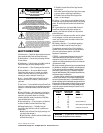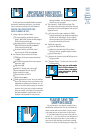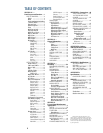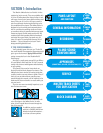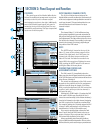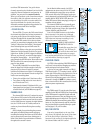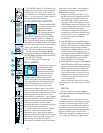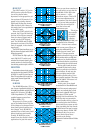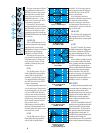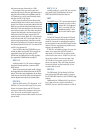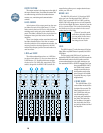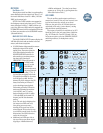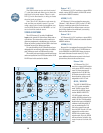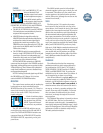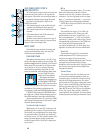
6
TRIM
TAPE
MIC/LINE
CHANNEL
16
GAIN
+4
–10
dBV
50
dB
10
dB
L
I
N
E
S
E
N
S
I
T
I
V
I
T
Y
M
I
C
G
A
I
N
-40
dBV
CHANNEL
16
MIC/LINE
LINE
IN
DIRECT
OUT
BAL-
UNBAL
INSERT
TIP = OUT
RING = IN
PHANTOM
POWER
+15
OO
U
MIX-B
LOW
CUT
SOURCE
FLIP SW
CHANNEL
PAN
LEVEL
SPLIT EQ
HI/LO EQ
TO MIX-B
MONITOR
LR
PA N
dB
30
20
10
5-6
3-4
1-2
7-8
L/R
MIX
-20
OL
OO
16
10
40
50
60
MUTE
5
5
SOLO
U
strip (via the source switch), can be achieved
by modifying the channels. See Appendix C:
Modifications on page 52.
1. When the Mix-B SOURCE switch (11) is
up, MIX-B receives its input from the FLIP
switch. Remember, the FLIP switch alter-
nates MIC/LINE or TAPE to the channel
strip and to MIX-B. With TAPE as an input
(SOURCE up to select the FLIP switch, and
FLIP in the up position), the MIX-B section
functions as a tape monitor submix,
allowing you to listen to the inputs and
outputs of your multi-track recorder as you
record. This is the most common use of the
MIX-B section, during tracking and
overdubbing.
2. With MIC/LINE as an input (SOURCE up to
select the FLIP switch, and FLIP in the down
position), MIX-B becomes an additional input
to add tracks or effects during a mixdown.
Simply plug the additional signal into the MIC
or LINE connector. Although they are nor-
mally separate, a button (MIX-B TO L/R MIX)
in the Output Panel (see below) can add the
output of the MIX-B buses to the L/R Mix
buses. Voilà! Double your mix inputs!
3. With CHANNEL as an input (SOURCE down in
CHANNEL position), MIX-B taps its signal from
the channel strip, just before the channel fader.
MIX-B is separately pan-able, EQ-able and
can be used as an alternative stereo mix, a
stereo auxiliary send, a “mix-minus” bus, a
quadraphonic or surround feed, you name
it. Mix B can also have its own aux send
(see Aux sends 3-6).
Check out Section 3: General Info and the
Block Diagram for more information on MIX-B
routing.
MIX-B PAN
The PAN control (12) routes the channel’s
MIX-B signal across the left and right MIX-B buses.
MIX-B LEVEL
The LEVEL control (13) sets the level of
the channel sent to the MIX-B buses. The gain
structure of this circuit (like the AUX send
1–6 circuits, below) includes extra amplifica-
tion. What this means to you is that you will
always have plenty of gonadotropic gain avail-
able for the MIX-B buses. Full left on the
LEVEL control is off; the midpoint of travel is
“U”, or unity gain; full right is 15dB of boost.
The MIC/LINE switch (9) is located way up
amongst the channel jacks. It selects whether
the MIC jack (pin 2=hot[+], pin 3=cold[–],
pin 1=shield) or the LINE jack (balanced 1/4"
phone… tip=hot, ring=cold, sleeve=shield) is
connected to the input amplifier.
THE FLIP SWITCH: MIC/LINE OR TAPE
The switch labeled FLIP
(10) selects the input that
is actually fed into the
channel fader (and the
MIX-B control; see below).
As the label indicates, the MIC/LINE input
(after Mic/Line preamp) is fed to the channel
fader when the FLIP switch is in the up posi-
tion. This is the normal mode for tracking and
overdubbing. In the down position, the TAPE re-
turn (the output signal from the corresponding
track of your recorder) is fed to the channel
fader. This is the normal position for mixdown.
To recap - when the FLIP is up, the Mic/Line
feeds channel and Tape return feeds MIX-B. When
the FLIP is down, the channel is Tape and MIX-B is
MIC/LINE. FLIP... FLOP. OK?
For live PA, leave the FLIP switch up.
MIX-B / MONITOR
Each channel strip has a
dual signal path (Enter
Mix-B!) with extremely
flexible switching. This al-
lows either the mic/line
inputs or tape return inputs to be routed
through either the channel fader path or
Mix-B with separate EQ and monitoring. Both
of the signal paths can be combined into the
main mix by depressing the Mix-B to L/R
Switch in the master section. OK, now we
jump down the channel again to the MIX-B/
Monitor section. This handy and very simple
feature is also called “in-line monitoring” and is
found on quite a few consoles. So we’re not
claiming that it’s anything new… we just added
some extra features for more flexibility. MIX-B/
Monitor routing options can get a bit compli-
cated, so pay attention. Also, we did add
something that other in-line monitoring systems
don’t have. So double pay attention.
The MIX-B buses are a stereo pair, indepen-
dent of the 8-plus-2 recording buses we’ve
talked about so far. There are three sources
available to MIX-B: MIC/LINE or TAPE (via the
FLIP switch) and the pre-fader output of the
channel strip (via the SOURCE switch). A
fourth source, post-fader output of the channel




